




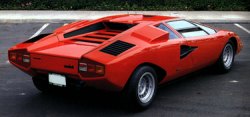
You may surprise how old fashion the Michelin XWX tyres were - 14 inches diameter, 70% profile, 205 mm width for the front wheels and 215 mm for the rear .... Obviously this is unsuitable to such a supercar.
However, also because of this, LP400 had better aerodynamic drag than its successors, therefore it is actually faster ( in top speed ) than LP400S and LP500S.
There is another unique feature in LP400 : instead of a normal rear-view
mirror, it has a periscope mirror recess in a characteristic groove on
the roof. With a nick eye, you can barely see the groove in the above right
hand side picture.
 |
The cabin is hopelessly cramped since the first Countach, thanks to the wide central tunnel, wide door sill and ultra-low roof. |
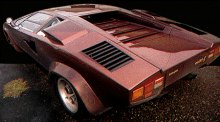
To accommodate wider tyres, extended wheel arches made of glass fiber were added, which also enhance the aggression of styling. Air dam was added under the nose, while a V-shape large rear wing was listed as a popular option for increasing high speed stability as well as visual aggression. Many people including me like the wing, but its extra drag cost at least 10 mph in top speed.
Even without the wing, LP400S had considerably higher aerodynamic drag than LP400, thanks to the widened wheel arches and tyres. This inevitably dropped the top speed, especially when the V12 is carried over without any change. Acceleration is also worse, because kerb weight was increased by about 50 kilograms.
However, if you judge a supercar also by handling, LP400S will never let you down - cornering ability is not in doubt anymore. Obviously, Lamborghini knew that an all time supercar must has handling to match with speed.
As mentioned already, the V12 did not change, but a more honest appraisal resulted in 353 hp instead of 375 hp.
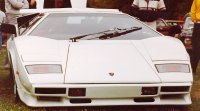
Also known as LP5000S in America, LP500S got an upgraded engine, now displaced at 4754c.c. by increasing 3.5 mm bore and 7 mm stroke. As much as 302 lbft of torque is available at 4,500 rpm, though tougher emission control prevented the power from exceeding 375hp. This V12 surely improved the disappointed performance - top speed rose to about 165 mph, while 0-60 mph was down to 5.6 sec.
There is no much change in other aspect. The body is simply the same as LP400S, except the roof was raised by 30 mm for better head room.
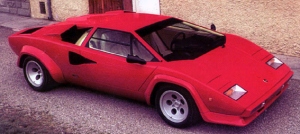
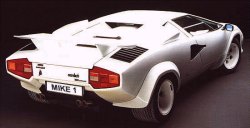
Forget the 200 mph dream, this will never be achieved with the same aerodynamic. As the body is virtually unchanged from LP500S, people were happy to see the QV could run up to slightly over 180 mph, which was among the fastest in the world. Ferrari 288GTO and Testarossa had more or less the same speed, while other competitors were quite far below than that.
Compare with the LP500S's engine, the 48 valves QV unit is very powerful and revvy, it is surely a gem. The extra power is mainly achieved from the larger valve area, and the repositioned Weber carburettors - now mounted vertically instead of horizontally to enable straight forward engine breathing. However, this resulted in a large mound on the engine lid, thus deteriorated the precious rear vision.
Other minor changes :
.

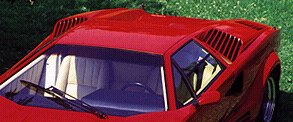
Mechanically, it was nearly the same as the 5000QV, except that several changes were made to shoot some long-existing problems. One of the old problem is the ventilation of brakes and engine. As you can see in the pictures, more ventilation holes were opened in the air dam, the side skirt and engine lid. The air box intakes were also enlarged. In styling, vertical grilles instead of horizontal was employed simply to refresh your eyes. However, the air dam and side skirts are particularly unmatched with the original styling. Personally I hate the new look very much.
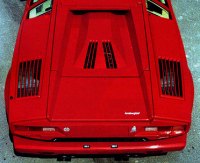 When
you know Lamborghini was already bought by Chrysler, you won't be surprised
to discover that electric seats and even power windows ( yes, those tiny
windows ! ) was made. Now the bumpers and side skirts are also made of
carbon fiber, perhaps to offset the weight of "power everything". Countach
was really changed .... it was no longer the pure performance machine that
inspired by Ferruccio Lamborghini, engineered by Paolo Stanzani and styled
by Marcello Gandini. After all, who want those luxury items in such a cramped
supercar ?
When
you know Lamborghini was already bought by Chrysler, you won't be surprised
to discover that electric seats and even power windows ( yes, those tiny
windows ! ) was made. Now the bumpers and side skirts are also made of
carbon fiber, perhaps to offset the weight of "power everything". Countach
was really changed .... it was no longer the pure performance machine that
inspired by Ferruccio Lamborghini, engineered by Paolo Stanzani and styled
by Marcello Gandini. After all, who want those luxury items in such a cramped
supercar ?
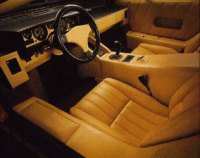 |